Tooltester is supported by readers like yourself. We may earn an affiliate commission when you purchase through our links, which enables us to offer our research for free.
Caught the blogging bug? Ready to polish that draft and press publish? Great! But which blog maker offers the best option if you want to start your own blog for free?
As you’ve guessed, there’s tons of free blogging platforms online, and not all of them are created equal. So the best one will vary depending on your needs:
- Do you want to reach a large audience?
- To join a community of like-minded people?
- To display your words as nicely as possible?
- Do you want to make money?
- Do you need a multilingual system?
Don’t worry, I’ll give you a good option for each answer. But first, let’s see how to get started:
Blog Makers: How to Start a Free Blog?
It starts with signing up. So it usually goes:
- Sign up to a free blogging site (an email address is usually enough)
- Create a username
- Pick a blog template
- Create a new post
- Add formatting (links, bold, etc…) and media
- Press publish.
And that’s it! At least it’s the case with the best solutions out there.
12 Free Blog Makers And Their Pros & Cons
- Weebly
- Wix
- WordPress.com
- WordPress.org
- Hubspot
- Medium
- Webnode
- Webflow
- Bookmark
- Blogger
- Tumblr
Weebly: Flexibility and Full Features for Free
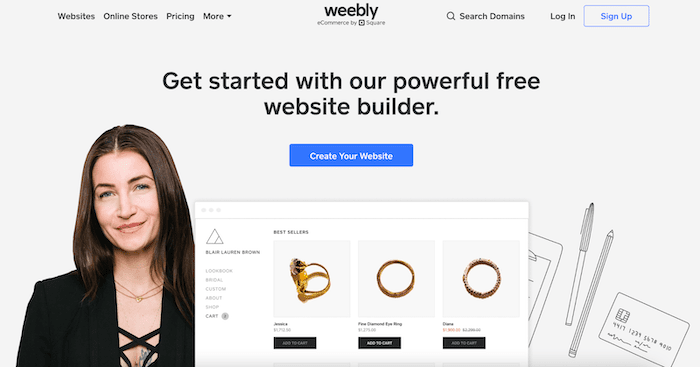
Weebly isn’t exactly a famous name in the blogging world, and I personally think it’s a shame. Their blogging solution is excellent, giving you great flexibility and customization options at your fingertips.
Your blog URL will look like myblogname.weebly.com, and the themes look good. You can also access the Weebly app market, even with a free plan. Aside from that, here are some pros of using Weebly as your free blog platform:
Pros of a free Weebly blog
- Probably one of the best drag and drop editors for blogs (you can place and move elements easily and wherever you like).
- Nice free responsive themes
- Good SEO options
- Social media sharing
- Post scheduling
Limitations of a free Weebly blog
- Big, obtrusive advert
- 500MB of storage
- Media limitations (no audio or video player)
- Can’t let users register
- Weebly haven’t updated the platform in a while, so you may be limited in the features you can add
What if I want to upgrade?
The first tier that removes that annoying ad is the Starter plan at $8 a month. It also gives you a free domain name for a year, and SSL protection.
> Try Start a blog with Weebly for free
Wix: The Big Daddy of Web Builders

Wix is the most used, most famous, and most recommended website builder in our book. They’ve clearly decided to make their free plan hard to resist, and it’s also the case if you want to build your first blog.
In fact, there are few feature restrictions in the free blog maker compared to the paid plans. Let’s see what you get for $0 a month:
Pros of a free Wix blog
- Fantastic templates selection
- Great for photo and visual blogs
- Access to royalty free images library
- Full access to the best web builder app store
- Basic email marketing and social media features
- Full SEO customization option
- Wix app for posting / managing on-the-go
Limitations of a free Wix blog
- Annoying static advert (bad on desktop, a bit better on mobile)
- 500 MB of storage on the free plan
- Lengthy domain name: accountname.wix.com/customname
- Readers need to sign in to comment
- No use of Google Analytics, but Wix has a built-in analytics tool
What if I want to upgrade?
You’ll need the Combo plan to remove ads ($16 per month). Includes free custom domain for a year, and it bumps storage limit up to 3GB.
> Start a blog with Wix for free
WordPress.com: The Blogging Powerhouse
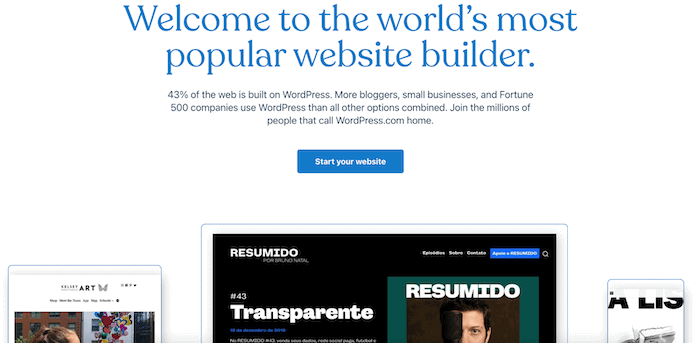
Ok, first things first, there’s WordPress.com and WordPress.org. It’s a bit confusing, but here’s how I remember it:
- WordPress.com – gives you a complete website with hosting.
- WordPress.org – you need to organize hosting yourself
This section is about the .com option. Learn all about the differences between .com and .org here. WordPress.com is essentially a platform where you can choose a free or paid plan and start using the blog builder instantly. Web hosting is included, and the software is preinstalled, so no need to set anything up.
While it’s a lot easier to get started, it also means there are more limitations. This is especially true with the free plan:
Pros of a free WordPress blog
- Good text and media management
- Fast, responsive editor
- Good looking, mobile-friendly themes
- Post scheduling
- Jetpack features (includes basic SEO, spam protection and social media post automation)
- Upload posts from mobile and desktop apps
- Great import / export functions
Limitations of a free WordPress blog
- 1GB of storage space with the free plan
- Displays WordPress ads
- Limited theme selection
- Basic theme customization options (colors, fonts, but not much else)
- Can’t install any plugins
What about the free WordPress.com blog themes?
There are around 80 free themes. It’s a great selection, and they are all fast, nice looking and mobile-responsive. But be aware that you won’t have full customization options (CSS and HTML) unless you move to a higher plan. Also, the premium themes aren’t available in the free plan.
What if I want to upgrade?
If you want to remove ads and use your own custom domain, WordPress’s Personal plan is an affordable option at $4 a month. However, to access plugins and SEO tools, you’ll need to shell out at least $25 per month for the Business plan, which is certainly not the most cost-effective option for a blog!
> Start a blog with WordPress for free
WordPress.org: Powerful But Complicated to Set Up
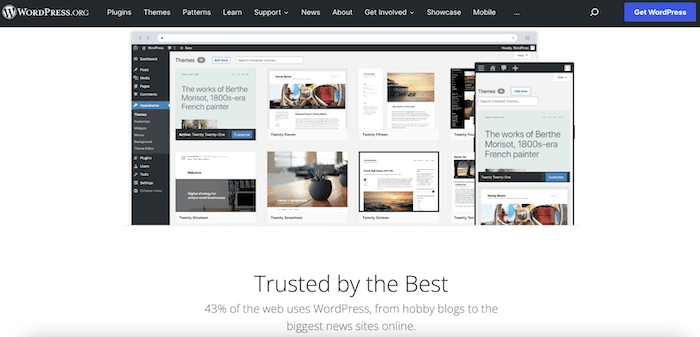
Now, let’s focus on the software you can find at WordPress.org. It’s worth saying it again: this is just the software, so you need to install it on your own server (ideally WordPress hosting), which usually won’t come for free. WordPress.org itself on the other hand is open source (free) and one of the most powerful content management systems you can get your hands on.
Unlike with the hosted version, you get access to all the features possible. And you can go very far with the free software, free plugins, and free templates. Let’s see what else you get when you use the WordPress.org software on your own site:
Pros of the free WordPress.org blogging platform
- One of the most powerful content management systems around
- Access hundreds of amazing plugins (free and paid)
- Install any theme you want (free and paid)
- Exhaustive SEO features
- Scale your blog however you see fit
- Huge community
Limitations of the free WordPress.org blogging platform
- Need to buy your own web hosting (although some bloggers might enjoy having control there)
- Quite complex for beginners
- Need to update manually (to be fair, most of the time you just need to click a few buttons)
- No official support
Hubspot CMS: Powerful Content Management Platform
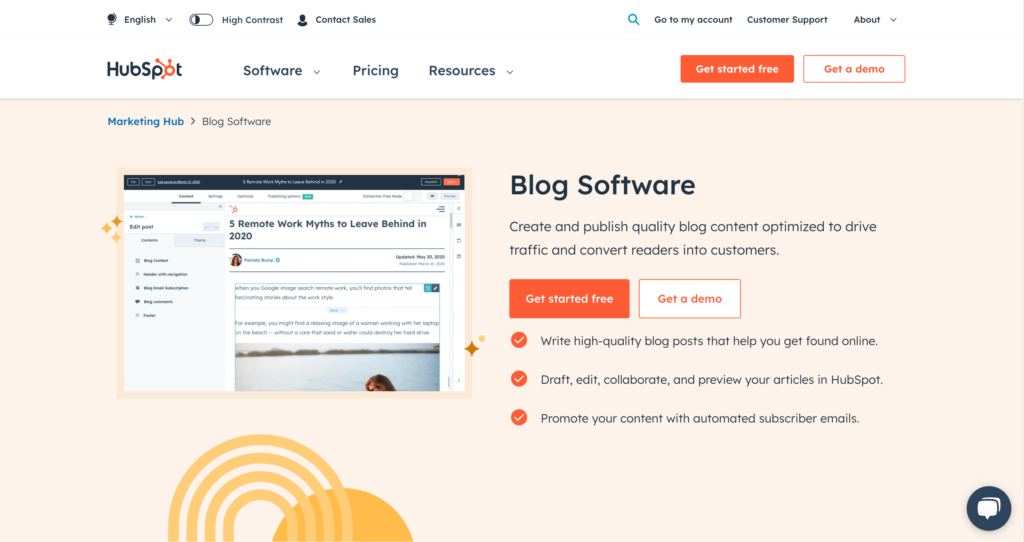
It’s more than likely that you’ve already heard of Hubspot, whether that’s as an email marketing platform or a CRM. Hubspot CMS Hub is a powerful content management platform that offers a wide range of useful features and an extremely intuitive interface.
One of their useful features is a free blogging feature ideal for websites of various scales. The blog maker feature helps users reach their audiences by publishing SEO-friendly content.
The HubSpot CMS Hub simplifies the customization of your website’s design and layout through an easy-to-to-use website builder, eliminating the need for coding expertise. Let’s see the advantages of using their free Blog Maker:
Advantages of HubSpot Blog Maker:
- Free custom domain connection
- User-friendly drag-and-drop blog builder
- Responsive templates with forms, CTA’s, and more.
- SEO optimization features
- Google AMP settings are available
- Built-in security settings: CDN and SSL certificates
Disadvantages of HubSpot Blog Maker:
- Does not support ecommerce
- Hubspots branding with free version
- Customization limits
Pricing:
Although you can “get started for free” it’s likely that you’ll want to upgrade pretty quickly due to the page limits and to remove Hubspot’s branding.
HubSpot CMS plans start at $25 per month, offering key features for maintaining a secure and aesthetically pleasing blog.
Furthermore, these plans include essential marketing tools to support your blog’s growth. Upgrading to higher-tier plans is recommended to unlock advanced features and receive SEO recommendations.
Medium: Minimalist Home of the Written Word
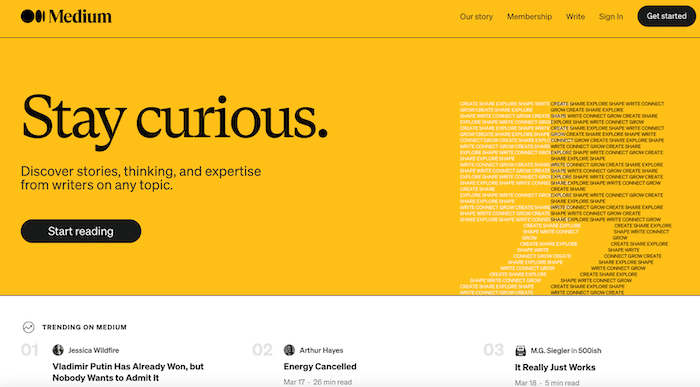
Launched in 2012 by one of Twitter’s founders, Medium.com wants to change the web’s blogging model. The goal is to create a place that rewards quality writing via the Medium Partner Program. There is no advertising, but readers are encouraged to pay a membership. Subscription fees are then divided amongst writers, based on various metrics such as subscriber count, engagement, and claps (the Medium equivalent of “likes”).
Blogging with Medium couldn’t be simpler. In fact, its minimalist, no-frills style is becoming the standard every blog should try to emulate. It puts typography front and forward, with no distractions and visual flourishes. You can tell it’s for people who love reading, by people who love writing.
Medium is also more than a blog maker: it’s also a community. With 60 Million users and counting, your posts will find an audience, even if it’s a small one at first.
Finally, a caveat: while I believe Medium is one of the best homes for bloggers, it’s certainly not the best blog maker. You’ll have little to no control over the design or customization options, features and tools.
Pros of a free Medium account
- Beautiful, minimalist typography
- Get (potentially) paid for your writing
- Easy signup and setup
- Connect with a huge audience
- No adverts
- Reputable platform (used by renowned journalists, entrepreneurs, politicians and writers)
- Can republish content from your other blogs (they even let you optimize it for SEO)
Cons of a free Medium account
- No control over the design
- Medium keeps pushing readers to download their app
- Hard to get search engines traffic
- Not good for photo blogs
- No personal domain name
- Niche-centric: not ideal for casual blogging
Webnode: For Polyglot Blogging
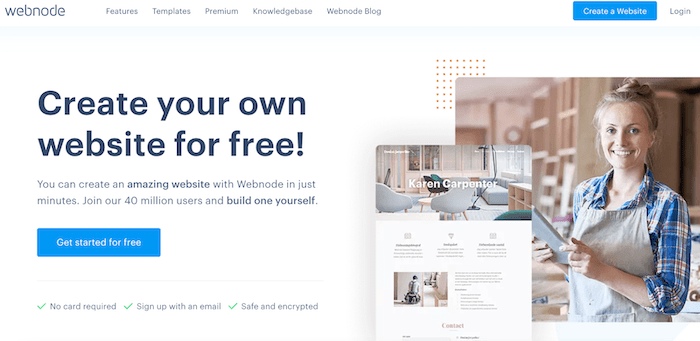
Webnode is yet another website maker that lets you create your own blog. It’s fairly unremarkable, except for one feature: you can enable multiple languages for your pages and posts, but not with the free plan.
Aside from that, the drag and drop editor is decent, and the templates are modern and responsive. You can attach a small online store, which is pretty neat, but not extraordinary.
Pros of a free Webnode blog
- Stylish templates
- Small ad
- Easy and intuitive
Limitations of a free Webnode blog
- 200 MB of storage
- 1 GB bandwidth
- No comment section
What if I want to upgrade?
There are two paid plans (Limited and Mini) that let you connect your custom domain, but you’ll need the Standard plan at $12.90 to remove ads.
> Start a blog with Webnode for free
Webflow: the creative way to start a blog
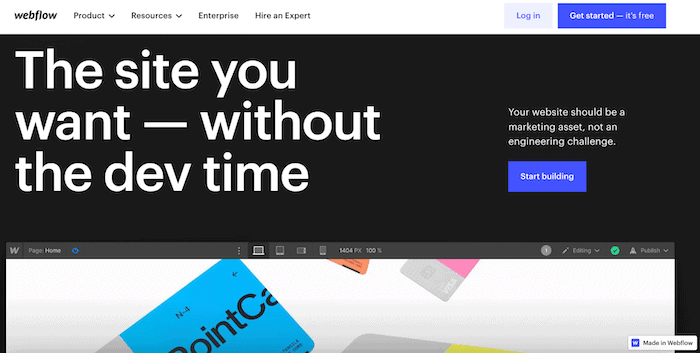
The San Francisco-based company Webflow is a mix between a website builder and a CMS. To some extent, it reminds me of WordPress, but it is easier to use and maintain. Besides, Webflow will host your site and it provides support in case you have issues…
You can fully customize the design through the visual editor: It is an excellent choice for designers and advanced users.
Pros of a free Webflow blog
- Flexibility: you can fully customize all aspects of the design (layout, HTML, styling, and more).
- Knowledge base: Webflow provides courses, videos and articles to help you build your website.
- Uptime: Webflow guarantees a 99.99% uptime.
Limitations of a free Webflow blog
- Complexity: the editor is powerful but it requires some time to get used to it.
- Article limit: the free plan lets you post a maximum of 50 blog articles only.
- Webflow subdomain: if you’re using the free plan, your site’s URL will be: mysite.webflow.io
- Pricing: plans can be confusing. Hard to know which one is appropriate.
- Missing features: Webflow would be much better with multilingual support and a user logins feature.
What if I want to upgrade?
Webflow offers 2 main plans for bloggers: the CMS Plan for beginners with 100,000 monthly visits: $29/month. And the Business plan, for high-traffic blogs at $49/month. You will find more information about their plans here.
> Start a blog with Webflow for free
Bookmark: AI-Powered Blog Designs
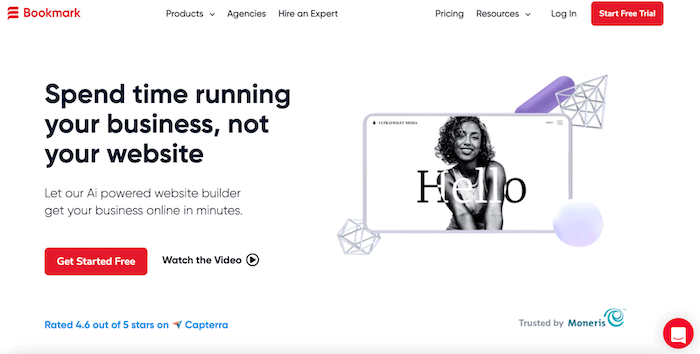
Bookmark is a website builder whose unique selling point is its artificial intelligence system. It’s actually not that unique (Wix and Jimdo have similar features) but it’s put front and center on their landing page.
In any case, it’s supposed to help design a nice looking blog. I tested it and the results were not bad. Maybe not enough of a selling point for me, but it’s still a decent option for a free blog maker.
Pros of a free Bookmark blog
- Fast, AI-powered setup
- Easy to use
- Simple interface
Limitations of a free Bookmark blog
- 1GB bandwidth per month
- 500 MB storage with the free plan
- Bookmark branding
- Rigid layouts
What if I want to upgrade?
Ad-free plans start at $11.99. Pretty steep compared to more established platforms like Wix or Weebly. You can also get a professional email address for $2 a month, which is pretty affordable.
> Start a blog with Bookmark for free
Blogger: Google’s Blogging Dinosaur
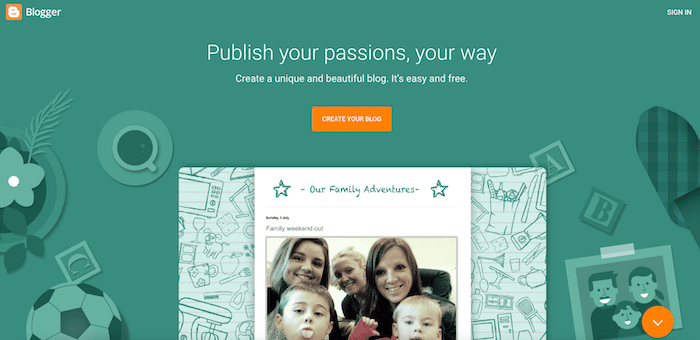
I wanted to add Blogger to this list because it’s still a famous service provided by Google. But in all honesty, it’s getting harder to recommend it to anyone starting in the blogging world these days. I’d be a bit worried it will soon join the Google graveyard of abandoned and killed products.
The main reason? It’s 15 years old, and it shows. The templates are sometimes slow to load. There hasn’t been any innovation behind the product in years. In 2020, there was only one post from their official blog.
But still, let’s not forget there might be advantages to using it, as you’ll see below:
Pros of a free Blogger blog
- Completely free with no ads
- Unlimited storage space
- Built-in analytics
- Integrate with other Google products (Photos, Drive, etc)
- Good for personal blogs
Limitations of a free Blogger blog
- Dated backend
- Slow to load sometimes
- Limited template selection
- Few customization options
LinkedIn: The New Place for free Business Blogs

You may know LinkedIn as one of two things: the invitation spam king, or the social network for corporate business. But it’s also an increasingly reputable publishing platform to write about topics such as: business, entrepreneurship, or finances, amongst others.
It’s free to join, not too complicated, and can boost your business profile by showcasing your articles to like-minded professionals. Like with Medium, it’s a good place to blog, but not a great blog maker per se. You can’t choose a template or control the design. It’s all LinkedIn branded stuff and hosting, which also makes it difficult to move your content to other platforms later.
Pros of a free LinkedIn account
- Great for business relationships
- Reputable platform
- Simple editor
- Reach an audience (your contacts first, then maybe other professionals)
Cons of a free LinkedIn account
- Only good for corporate / business writing
- Can’t connect to your domain (but you can claim a public LinkedIn URL)
- No customization options
- Aggressive email marketing (for your contacts)
Tumblr: MicroBlogging and Social Media
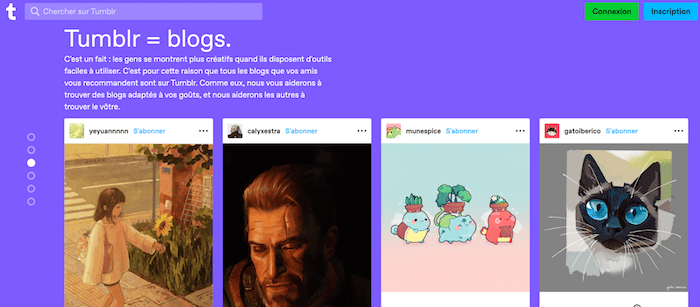
Tumblr was notoriously acquired by Yahoo for a whopping $1.1B in 2013, something its users were not happy about. In fact, you might know Tumblr users for being a vocal bunch. The community there is close-knit, engaged and often prone to controversies.
Its user base, however, is Tumblr’s biggest asset. The site gets 550M monthly visitors and hosts more than 459M blogs. It’s designed to work as a social network, where you are encouraged to Reblog people’s content, subscribe to their feeds, and generally comment and share each other’s work.
But how’s the actual blogging? Pretty short and niche, you’ll find. Tumblr is the number one home for microblogging, where users focus on short, shareable content. It is also heavily skewed towards visual content. Illustrators, graphic designers and photographers do really well there (although its popularity is increasingly eclipsed by Instagram).
Pros of a free Tumblr blog
- Completely free with no ads
- Intuitive interface
- Join a huge, active community
- Unlimited storage
- Great content management
Limitations of a free Tumblr blog
- 250 posts and 75 images per day (still a huge number)
- Files can’t be larger than 10MB, or 1MB for GIF files
- Not ideal for lengthy posts
- No analytics or SEO
- Limited free themes
- Really only suitable for a personal blog
What if I want to upgrade?
You can connect your tumblr to a domain name for free. There are also premium themes that will set you back between $9 to $49 on average.
Honorable Mentions: Ghost, Postachio and LiveJournal
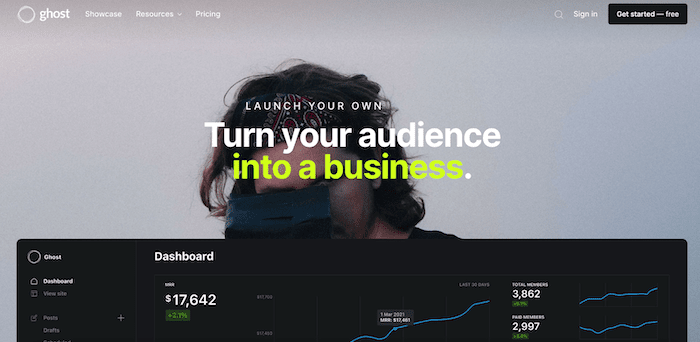
A few more options for very specific cases before we wrap this up. Ghost is a professional publishing platform that is fantastic if you want to start a whole online publication. Maybe it’s a bit over the top for a lone blogger, but it’s a powerful, open source tool. Paid plans start at $29 a month for a team of 2, and there is also a free trial.
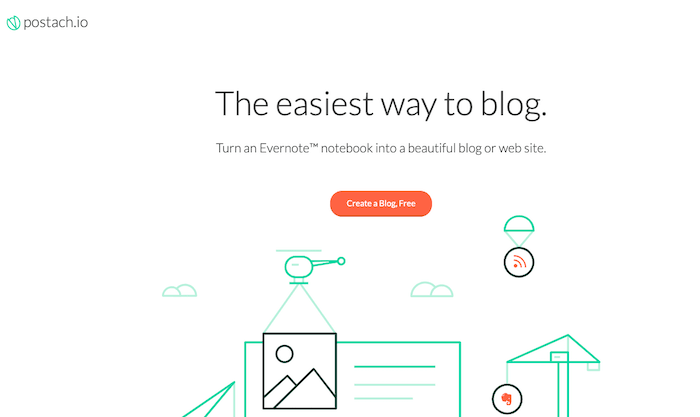
Postachio is a neat little website that is part of the Evernote family. It allows you to turn your Evernote content into a simple blog post. You connect your notebook and tag public content as #publish. Features are a bit lacking, but you get Disqus comments, content embedding, and Dropbox storage option.

And last but not least, LiveJournal, possibly the oldest blog maker on this list (started in 1999!). Its age is apparent in the backend, but it’s the community of die-hard users that make it an interesting place to share your ideas, thoughts, and daily musings.
Wait a Second – Why are these blogging sites so cheap?
That’s a good point! It depends on the platform, but it’s usually one of these three reasons
- They have a priced option they hope you’ll upgrade to later (Freemium model)
- They want to grow their user base so it looks good to advertisers / shareholders / investors
- They display their logo / branding on your free blog posts, so you’re providing them with free marketing
Free vs Paid Blogging Platforms…
Yes, unfortunately. With the aforementioned freemium models, providers will curb the number of features as an incentive to make you purchase subscriptions. Standard limitations are:
- No professional domain names: your blog will be hosted at www.your-blog-name.platform.com. Doesn’t make you look like an established blogger.
- Can’t remove ads: also another thing that screams “cheap”.
- Limited storage: you’ll be constrained in terms of data space. While text only accounts for a few kilobytes, images and other media are heavier.
- Limited bandwidth: if too many people read your words, you’ll reach a monthly cap and the blog will be taken offline.
If you have a small budget to start your blog, do check out our review of the 5 Best Website Builders for Blogging.
Starting a blog: What About SEO?
If you plan on getting traffic from Google and other search engines, good luck. While it’s not impossible to rank high with website builders, it’s going to be an uphill battle with free options. The reason? Search engines like proper domain names. That’s something you have to pay for, there’s no way around it.
Then, there’s a few other issues. Search engine optimization is best performed by adhering to structured page formats, and free platforms won’t always provide it (page URL, title tags, meta description, etc…)
As we’ve noted in our review of the best free website builders: if SEO is important for you, go for a cheap option rather than a free one.
Last Thoughts on the Best Free Blogging Platform Out There Today
So, with cheap blog makers, it’s horses for courses. If I had to choose, I’d say Weebly or Webnode are the top free blogging sites for their ease of use and features.
However, one of the biggest challenges for novice bloggers is finding an audience. You’ll often feel like you’re posting into a void, which is why joining a community can be a tremendous boost. That’s why I’d say Medium and also LinkedIn are great home for bloggers. Their big advantage is the community aspect that will immediately point eyeballs to your posts.
Ideally you combine Medium and LinkedIn with a free blogging platform.
Still, breaking it down, it will look like this depending on if you want to:
- find the best combination of features and ease of use: go for Webnode or Weebly.
- create a beautiful blog: Wix has the best out-of-the-box templates.
- be paid for your writing: Medium wins this one.
- gain traction and find readers: Medium for niche blogging. LinkedIn for business and career focussed topics. Tumblr for image-heavy posts.
- the most robust content management system: WordPress.org is a great, industry-standard tool to learn. Plus, you can easily export your blog to other platforms later. Webflow is a good contender, too.
- attract traffic via SEO: WordPress, Wix, Weebly and Webflow are great options.
- use your blog to network: LinkedIn is your best friend.
- create a multilingual blog: Webnode is the best (but not free)
And finally, if you want to build a whole free website with your blog, remember that Wix and Weebly aren’t your only option. Do check our guide on free website builders here because most of them let you attach a simple blog for free.
Ready to get started? Make sure you also read our article on what makes a successful blog!
FAQ
In most cases you can. For instance, Wix has a handy list of ways you can monetize, and so does Weebly. It’s usually possible to enable an ad network (like AdSense) and to post affiliate marketing links, even with free plans.
However, there are restrictions, for instance with WordPress and Medium. The latter has its unique monetization system, which you can read more about below. Just make sure you read the terms of service if you plan on implementing monetization in your blog from the start.
We keep our content up to date
28 Nov 2023 - Added Hubspot
23 Feb 2023 - Smaller additions
20 Oct 2022 - New video Webflow
21 Sep 2022 - A couple of smaller updates and corrections
20 Apr 2022 - Change to WordPress.com plans
23 Mar 2022 - Webflow, new banner and general update
THE BEHIND THE SCENES OF THIS BLOG
This article has been written and researched following a precise methodology.
Our methodology



